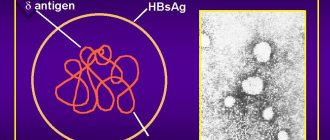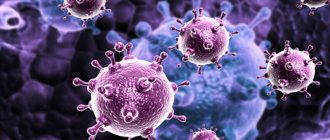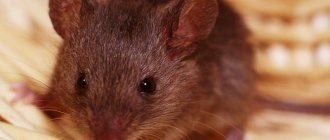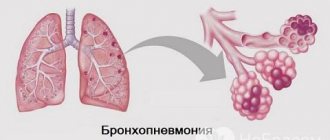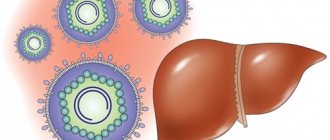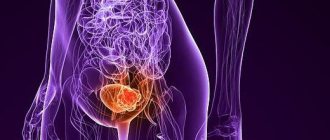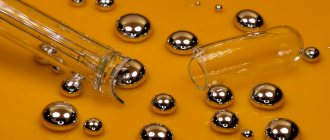Types of diathesis with causes of development
Depending on the provoking factors, diathesis that occurs in adults is divided into the following types:
- Neuro-arthritic. Rashes on the body appear due to increased nervous excitability.
- Allergic. This is the most common form. The skin rash resembles that which occurs with allergies. If you do not pay attention to the development of the process, problems with the respiratory system begin. The reason for the development of exudative diathesis (the second name of this form) is intolerance to any substances - allergens. They can be food, pollen, medicines, etc.
- Lymphatic-hypoplastic. Characterized by damage to the mucous membranes. It occurs due to various infections that have entered the body.
- Hemorrhagic. The cause of this condition is the body’s tendency to hemorrhage. Characterized by frequent bleeding.
- Gastrointestinal. Bacteriosis, colic in the intestines, problems with the digestive system are common symptoms of this condition. The causes of gastrointestinal diathesis can be diseases of internal organs, abuse of fatty, spicy, salty foods, and alcohol.
It happens that an adult suffers from several types of diathesis.
Neuro-arthritic diathesis
With neuro-arthritic diathesis, it is important to follow a diet. What can you feed your baby:
- fruits vegetables;
- products made from rye flour;
- cereals containing starch;
- milk products.
Diet restrictions:
- fats;
- sweets;
- mushrooms;
- meat, including poultry;
- nuts;
- fish.
Complete refusal of such products:
- cocoa, coffee;
- offal;
- chocolate;
- carbonated drinks;
- legumes;
- rich broths.
Drug therapy is based on drugs that affect the synthesis of uric acid, its excretion and reduction in the level of ketone bodies:
- Allopurinol;
- Urodan;
- Etamide;
- Calcium pantothenate.
Choleretic, sedatives, and B vitamins are also used. For acetonemic vomiting, gastric lavage and a cleansing enema are necessary.
Typical symptoms
Unlike children, in whom diathesis appears most often on the face, in adults the rashes are localized on the arms, back, legs and neck. In addition to this symptom, there are others:
- increased skin sensitivity, dryness and flaking;
- swelling that does not go away for a long time;
- covering the rashes with crusts;
- pain in the areas of the rash, accompanied by itching of the skin;
- redness and tearing of the eyes, irritation of the mucous membranes;
- sleep problems.
Symptoms develop quickly - within 10-15 minutes after eating food, contact with household chemicals or other allergen.
If diathesis appears for the first time, a person does not focus on it. The unpleasant condition passes quickly. But with each subsequent time, the symptoms become more and more protracted, and treatment becomes more complicated if it is not started in a timely manner.
Baby care
As a rule, the tendency to allergies is not limited to skin manifestations, and over time the child's sensitivity to other potential allergens increases. To reduce the risk of sensitization of the child’s body, follow a number of basic measures:
- Use clothes only made from natural fabrics.
- Wash your baby's clothes and diapers, as well as your own home clothes, with special baby powder or baby soap, and then iron them (high temperature destroys allergens).
- Do not have pets, and if you already have one, avoid contact between the animal and the child. The animal should not enter the room where the baby sleeps.
- Do not give your baby soft toys, and check hard toys made of plastic and rubber for a quality certificate.
- Try to do wet cleaning at least in the baby's room every day.
- Minimize the number of “dust collectors” (upholstered furniture, carpets, books and clothes in uncovered closets, etc.) in the baby’s room.
- To care for your child's skin and hair, use special medicinal children's cosmetics. It is not necessary to purchase expensive brands, but it should be medicinal cosmetics (Emolium, Lipikar lines, creams such as Bepanten, Skin-cap, Topicrem). Special products carefully moisturize the skin without causing irritation or allergic reactions.
If your child is sick, do not give him medications without a doctor's prescription - many medications contain allergenic flavors and dyes.
Treatment Options
After carrying out diagnostic procedures, the doctor determines how to treat patients. Therapy involves the use of external agents and oral medications. Traditional medicine offers its own methods. Particular attention is paid to nutrition.
Local preparations
Ointment for diathesis in adults is used most often. The most commonly prescribed drugs are:
- Zinc ointment. It has proven itself well as an antiseptic. The medicinal composition is applied in a thin layer to the lesion. The procedure is repeated 2 times a day. The duration of the course depends on how affected the skin is. Your doctor will help you decide on this.
- "Advantan". This ointment contains hormonal substances. The drug has a greasy consistency and is quickly absorbed after application to the skin. Under the influence of Advantan, the rashes decrease and the itching goes away. Due to the hormones included in the drug, the course of treatment is limited to 1.5 months.
- "Elidel". Available in cream form. The composition includes pimecrolimus, a substance that has an anti-inflammatory effect. The cream is rubbed into the skin 2 times a day. The duration of therapy depends on the speed of healing of the affected areas.
Medicines for internal use
Antihistamines, such as Suprastin, are widely used in the treatment of diathesis. It contains chloropyribenzamine. Available in the form of tablets, which are recommended to be taken before breakfast, lunch and dinner. The medicine has many contraindications, incl. failure of the heart muscle, problems with the gastrointestinal tract. It is recommended to read the instructions for use.
Loratadine has the same effect as Suprastin. But the tablets are taken 1 time per day, 1 piece.
For diathesis, Finistil can be prescribed in the form of drops. A single dose is 30 drops. The frequency of administration is 3 times a day.
ethnoscience
Traditional medicine offers many recipes that help eliminate the symptoms of diathesis. Often, making home remedies requires ingredients that are found in every home. So, you can prepare a decoction based on bay leaves. To do this, put the leaves (5 pieces) in water (250 ml), bring to a boil and leave on low heat for 15 minutes. Allow the product to cool, and then wipe the affected areas of the skin with it 5-7 times a day. The decoction is suitable for treating diathesis on any part of the body, incl. on foot.
Black radish juice is suitable for oral administration. It is taken 1 tbsp. l. 3 times a day half an hour before meals.
For diathesis on the cheeks, you can use a compress, the composition of which is prepared from cabbage leaves. It is necessary to boil 2 leaves in milk, grind them through a sieve, mix with a small amount of bran so that a paste is obtained. It is applied to the affected area and left to act for 10 minutes. Then you should rinse your skin with cool water. The procedure is repeated 2 times a day until the rash completely disappears.
Dietary ration
The daily diet of a person suffering from diathesis should include vegetable casseroles, oatmeal and rice porridges cooked in water, fruits (except citrus fruits), low-fat or low-fat fermented milk products.
You will have to give up chocolate, milk, eggs and all foods that cause allergies. It is necessary to exclude unhealthy foods from the menu - salted, fried, smoked, pickled. It is advisable to reduce sugar consumption to a minimum.
How to treat diathesis in a child
Treatment of a baby with atopic dermatitis or diathesis can only be comprehensive. The main treatment is prescribed by a doctor. On the part of the mother, a set of measures should be taken to care for a child with diathesis.
Mom's menu
The first thing a nursing mother does is review her menu. Cocoa, chocolate, smoked meats, poultry, tomatoes, and spices are excluded from food. Minimize eggs, milk. Increase your vegetable dishes, eat more fruits. If a mother tries a new product, she needs to monitor the baby’s skin reaction.
Child nutrition
Do not give your baby fish, eggs, wild strawberries, strawberries, tomatoes, oranges, tangerines. Limit salt. Increase foods with a lot of potassium in your diet: potatoes, dried apricots, raisins, prunes.
In children who are bottle-fed, milk is replaced with fermented milk mixtures. Add kefir, biolact, and yogurt to complementary foods.
When introducing new products to the menu, do not offer your baby more than 1 new dish. Watch the “reaction” on your baby’s skin.
Vitamins
The child is prescribed vitamins B, A, E, C. Give more freshly squeezed juices. Tomato, carrot, pumpkin, strawberry, and citrus juices should not be given for diathesis and dermatitis.
Local treatment
When a child has diathesis, traditional medicine recipes are used.
lotions with medicines, herbal infusions, and oils soothe the skin when itching.
Sea buckthorn oil and rosehip oil give a good effect. But first they should be boiled and strained.
Baths for atopic dermatitis are done daily. Because they provide the desired anti-inflammatory and antiseptic effect. Good for relieving itchy baby's skin .
Clothes, underwear
You cannot use synthetic powders for washing children's clothes, diapers, and bed linen. Only special children's hypoallergenic powders and baby soap.
Concept and characteristics
Diathesis on a child’s cheeks - photo:
Diathesis is a type of dermatitis and is of an allergic nature. The risk group for the disease includes infants during their first feeding, but in older children the pathology is also not uncommon.
Diathesis on the cheeks is caused by a specific reaction of the child’s body to a specific irritant or allergen. The danger of this disease lies in the likelihood of acquiring a chronic form.
Types of diathesis on the cheeks in children:
- allergic form (develops against the background of weakened intestinal function);
- neuro-arthritic form (an allergic reaction associated with the child’s nervous system);
- hypoplastic form (the disease is provoked by deviations of the endocrine system and some heart pathologies).
Diagnostics
The diagnosis of allergic diathesis is established based on medical history and basic clinical symptoms. In order to exclude diseases such as eczema, dermatitis and psoriasis, differential diagnosis is carried out, and if necessary, they also visit an allergist. To establish a diagnosis of lymphatic-hypoplastic diathesis, hereditary diseases along with intrauterine infections are additionally studied. In the neuro-arthritic form of the disease, diagnosis is carried out simultaneously with genetic analysis, performing a study of the amount of urate in urine.
Why is diathesis dangerous?
Exudative diathesis in young children can be complicated by seborrheic dermatitis and eczema. Persistent diaper rash is prone to merging, forming large areas of damage and developing into atopic dermatitis.
Children with neuro-arthritic diathesis in adolescence often develop renal failure, obesity, urolithiasis, and diabetes mellitus.
Children with constitutional abnormalities are prone to developing bronchial asthma.
Hemorrhagic diathesis is fraught with iron deficiency anemia, immune disorders, paralysis, blindness, and anemic coma.
Treatment of exudative-catarrhal diathesis
In most cases, it is possible to eliminate exudative diathesis in children by following a diet. A balanced diet based on age, excluding allergens, can prevent pathology in the future and reduce the risk of its reoccurrence. Mandatory components of complex therapy are:
- normalization of the daily routine;
- rehabilitation of chronic foci of infection in the body.
Principles of treatment of exudative-catarrhal diathesis
After exudative diathesis is diagnosed, treatment begins with normalizing the diet.
Doctors recommend following these rules:
- The basis of the diet of children under one year old should be breast milk.
- Excess animal fats are excluded from the diet of older children, replacing them by a third with vegetable fats.
- Strict restriction in the diet of carbohydrates - sugar, cereals, jelly.
- Elimination of allergens.
To maintain the general strength of the body and normalize metabolic processes, it is necessary to monitor the intake of vitamins in sufficient quantities:
- vitamin A;
- B vitamins: B5, B6, B12.
Local therapy for diathesis involves regular treatment of rashes and skin lesions:
- Areas of gneiss are lubricated with boiled vegetable oil, after 1 hour they are washed off with shampoo and the crusts are removed.
- Rashes on the limbs and torso are treated with special ointments: sulfur, ichthyol, zinc.
Therapeutic baths using:
- sequences;
- chamomile;
- oak bark.
Diet for exudative-catarrhal diathesis
Diet for diathesis should completely exclude allergenic foods. The diet must be selected according to the age of the child. So, if the baby is breastfed, it is recommended to introduce complementary foods no earlier than 6–7 months, starting with vegetable purees. When artificial feeding, the basis of the diet should be hypoallergenic mixtures - hydrolyzed or soy.
In young children, limit the amount of cow's milk consumed, replacing it with biolact, kefir and similar dairy products. For babies older than one year, the daily volume of milk they drink is reduced to 400 ml. In addition, portions of soups, broths and other liquids entering the body are limited. Meat is served exclusively boiled. Highly allergenic foods are excluded from the diet:
- oranges and other citrus fruits;
- chocolate;
- bananas;
- tomatoes;
- cocoa;
- strawberries;
- honey.
Video on the topic
Dr. Komarovsky about what diathesis is and whether it needs to be treated:
Thus, diathesis occurs in many children. Its treatment must be approached comprehensively. A breastfeeding woman needs to adhere to a special diet. If a child receives complementary foods, then from his diet it is worth excluding all foods that are difficult to digest and can provoke an allergic reaction and dermatitis.
Anti-inflammatory and drying ointments, sedative and immunomodulating tablets, and sorbents are used as medications. Traditional methods give a good effect.
Lymphatic-hypoplastic diathesis
Children who suffer from this disease are inactive, prefer quiet games, look loose and fair-skinned, and are prone to excess body weight.
They suffer from colds more often than others.
Delicate skin is especially sensitive to external factors; diaper rash appears on the buttocks and in the folds of the skin. Contact dermatitis also occurs.
Lymph nodes are enlarged in most cases.
During examination, as a rule, an enlarged thymus gland (thymus) is also detected.
Often these children have enlarged tonsils and adenoids, so they need to consult an otolaryngologist. Attempts to send a child to kindergarten lead to constant rhinitis and bronchitis.

